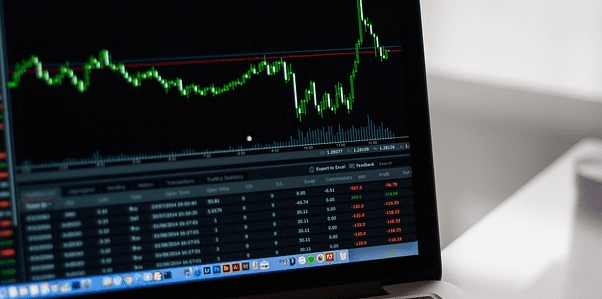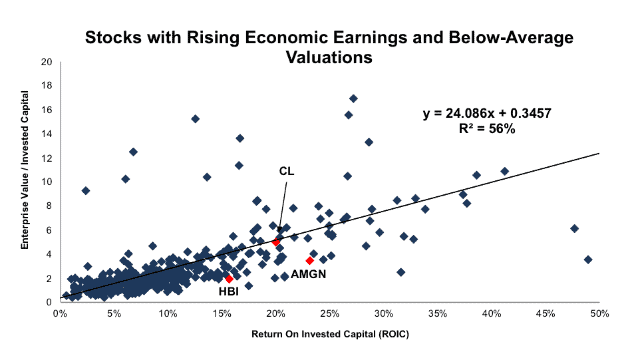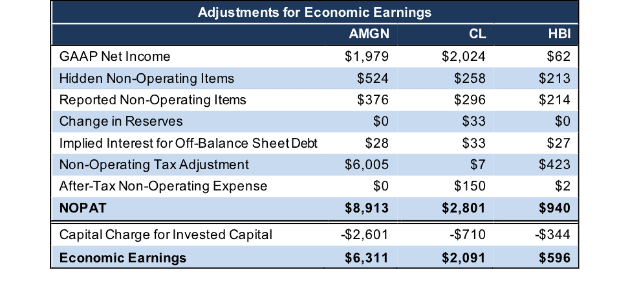We published an update on CL on May 11, 2022. A copy of the associated Earnings Update report is here.
Reported earnings numbers may drive short-term stock price movements, but in the long-term, markets allocate capital to the firms that generate the greatest return per dollar invested into the business. Analysts and investors have historically focused on reported earnings due to the difficulty of measuring return on invested capital (ROIC) accurately at scale.
Accurately measuring the return a business generates requires numerous accounting adjustments and analysis of the footnotes and MD&A of 10-K filings. By performing this diligence, one can calculate a business’ true economic earnings, invested capital, after-tax profit (NOPAT), and ROIC[1]. Through this research, we found five stocks with rising economic earnings that the market might have overlooked due to declining GAAP earnings. This week we highlight three of these stocks as Long Ideas: Amgen Inc. (AMGN: $183/share), Colgate-Palmolive Company (CL: $71/share), and Hanesbrands Inc. (HBI: $19/share).
Diligence Reveals Undervalued Stocks
During filing season, we leverage our Robo-Analyst technology[2] to parse and analyze ~2,000 10-Ks. Since mid-February, we have made 38,887 adjustments to reported income statements and balance sheets with a dollar value of $13.7 trillion.
Through this work, we are able to identify firms whose 2017 reported GAAP net income understates the true profitability of the firm. In the S&P 500, 46 stocks with either a 12/31 or 1/31 fiscal year end reported falling GAAP net income but grew economic earnings in 2017. Of this group, 15 receive an Attractive-or-better rating, which not only takes into account quality of earnings, but also a stock’s valuation. We then analyzed these 15 stocks to determine which were undervalued relative to the overall market.
Figure 1: Identifying the Cheapest Stocks in the S&P 500 Based on ROIC
Sources: New Constructs, LLC and company filings
Per Figure 1, Amgen, Colgate-Palmolive Company and Hanesbrands are all trading below their fair valuation based on relative ROIC.
Accounting Adjustments Reveal Profitability Greater Than Reported
Investors looking for value in the current volatile market should start with the stocks highlighted above. Per Figure 2, each of these stocks grew economic earnings in 2017 despite reported GAAP net income declining.
Figure 2: Change in GAAP Net Income vs. Change in Economic Earnings in 2017
Sources: New Constructs, LLC and company filings
The disconnect in net income and economic earnings is caused by accounting rules that fail to adequately measure the true cash flows of a business. Items such as asset write-downs, non-operating expense, off-balance sheet debt, over/under-funded pensions, and excess cash must be accounted for when analyzing income statements and balance sheets. Figure 3 highlights the adjustments made to AMGN, CL and HBI’s 2017 10-K to calculate economic earnings.
Figure 3: Economic Earnings Greater than Reported GAAP Net Income
Sources: New Constructs, LLC and company filings
Amgen Inc. (AMGN: $183/share)
Amgen, a biotech that closely resembles a traditional pharma firm, reported a 74% decline in GAAP net income in 2017 but economic earnings grew 4%. Much of this decline can be attributed to a $6.1 billion charge related to 2017 Tax Act, but there remain expenses hidden in operating earnings that cause significant understatement of AMGN’s reported profitability.
On page 51, AMGN disclosed $88 million in restructuring costs and $146 million in pre-tax expenses related to Hurricane Maria. Then, on page F-13 (page 89 overall), the firm disclosed an impairment charge of $400 million related to the discontinuation of development of AMG 899. These one-time costs are hidden within operating expenses and artificially reduce reported GAAP net income.
On the balance sheet, we add $559 million in off-balance sheet operating leases and another $679 million in accumulated other comprehensive income to our calculation of invested capital. Doing so allows us to hold a business accountable for all capital invested in the business and calculate an accurate ROIC.
As with all the companies in Figure 3, Amgen’s true profitability is not only greater than its reported earnings, but the stock is currently undervalued. Since we first featured AMGN as a Long Idea in May 2017, the stock is up 12% while the S&P 500 is up 13%. If AMGN was valued in line with the rest of the market, or at the level implied by the trend line in Figure 1, the stock would be worth $310/share today – a 70% upside.
At its current price of $183/share, the stock has a price-to-economic book value (PEBV) ratio of 1.0. This ratio means the market expects AMGN’s NOPAT to never meaningfully grow from current levels. This expectation would seem rather pessimistic given that the firm has grown NOPAT by 11% compounded annually since 2012.
Colgate-Palmolive Company (CL: $71/share)
We first featured Colgate-Palmolive in November 2010. Since then, the stock is up 73% while the S&P 500 is up 122%. This manufacturer of numerous consumer products (toothpaste, soaps, deodorants, detergents, shampoos, etc.) reported a 17% decline in GAAP net income in 2017 but economic earnings grew 1%.
On page 79, CL reported an additional $75 million and $89 million in cost of sales and selling, general, and administrative costs, respectively. These non-recurring costs were related to restructuring implementations and are hidden in operating income. Additionally, on page 97, CL reports $94 million in non-operating net periodic benefit costs related to its pension plans.
On the balance sheet, we add $642 million in off-balance sheet operating leases, $3.9 billion in accumulated OCI, and $993 million in assets write-downs to invested capital. These three adjustments are quite significant and, when combined, equal 59% of reported net assets.
After all adjustments, we see that CL’s profitability is not recognized by its current valuation. At its current price of $71/share, CL has a PEBV ratio 1.3. This ratio means the market expects CL’s NOPAT to grow by 30% over the remaining life of the firm. Meanwhile, CL has grown NOPAT by 6% compounded annually since 1998. If the firm can maintain 2017 pre-tax margins (27%), reap the expected benefit of lowered corporate tax rates, and grow NOPAT by 6% compounded annually for the next decade, the stock is worth $93/share today – a 31% upside.
Hanesbrands Inc. (HBI: $19/share)
Hanesbrands, a manufacturer of bras, underwear, socks, and more for men, women, and children, reported an 89% decline in GAAP net income in 2017 but economic earnings grew 1%. Similar to AMGN, HBI reported a $457 million charge related to the U.S. tax reform, but that was not the only item hidden in its 10-K. In total, we found $213 million (344% of GAAP net income) in non-operating expenses hidden in operating earnings.
On page F-39 (page 91 overall), HBI reported $18 million in non-operating net periodic benefit costs related to its pension plans. On page F-49 (page 101 overall), HBI revealed that $55 million and $109 million in one-time acquisition and integration costs were included in the cost of sales and selling, general, and administrative line items on the income statement. Also, on this page, HBI reported it incurred over $23 million in employee termination charges.
To calculate invested capital, we removed $235 million in deferred tax assets and $98 million in excess cash. We added back $527 million in off-balance sheet operating leases, $439 million in accumulated OCI, and $173 million in accumulated asset write-downs. Write-downs allow management to erase equity from the balance sheet, which then inflates any return on asset/capital metric. We add back asset write-downs to hold companies accountable for all the capital invested in their business.
Despite the improvement in economic earnings in 2017, the current expectations baked into HBI imply a significant cut in profits. At its current price of $19/share, HBI has a PEBV ratio of 0.6. This ratio means the market expects HBI’s NOPAT to permanently decline by 40%. Such a decline may seem reasonable if one just glanced at the large drop in net income in 2017. However, NOPAT has grown 12% compounded annually over the past decade.
If HBI can maintain current NOPAT margins (15%) and grow NOPAT by just 2% compounded annually for the next decade, the stock is worth $39/share today – a 105% upside.
This article originally published on March 21, 2018.
Disclosure: David Trainer, Sam McBride, and Kyle Guske II receive no compensation to write about any specific stock, style, or theme.
Follow us on Twitter, Facebook, LinkedIn, and StockTwits for real-time alerts on all our research.
[1] Ernst & Young’s recent white paper, “Getting ROIC Right”, proves the superiority of our research and analytics.
[2] Harvard Business School features the powerful impact of our research automation technology in the case New Constructs: Disrupting Fundamental Analysis with Robo-Analysts.
Click here to download a PDF of this report.
Photo Credit: StockSnap (Pixabay)



